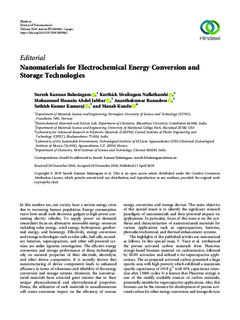| dc.contributor.author | Balasingam, Suresh Kannan | |
| dc.contributor.author | Sivalingam Nallathambi, Karthick | |
| dc.contributor.author | Abdul Jabbar, Mohammed Hussain | |
| dc.contributor.author | Ramadoss, Ananthakumar | |
| dc.contributor.author | Kamaraj, Sathish Kumar | |
| dc.contributor.author | Kundu, Manab | |
| dc.date.accessioned | 2019-10-03T08:05:24Z | |
| dc.date.available | 2019-10-03T08:05:24Z | |
| dc.date.created | 2019-05-29T11:46:35Z | |
| dc.date.issued | 2019 | |
| dc.identifier.citation | Journal of Nanomaterials. 2019, 2019 . | nb_NO |
| dc.identifier.issn | 1687-4110 | |
| dc.identifier.uri | http://hdl.handle.net/11250/2619965 | |
| dc.description.abstract | In this modern era, our society faces a serious energy crisis due to increasing human population. Energy consumption starts from small-scale electronic gadgets to high power consuming electric vehicles. To supply power on demand, researchers focus on alternative renewable energy resources including solar energy, wind energy, hydropower, geothermal energy, and bioenergy. Effectively, energy conversion and storage technologies such as solar cells, fuel cells, secondary batteries, supercapacitors, and other self-powered systems are under rigorous investigation. The efficient energy conversion and storage performance of those technologies rely on material properties of their electrode, electrolyte, and other device components. It is recently known that nanostructuring of device components leads to enhanced efficiency in terms of robustness and reliability of the energy conversion and storage systems. Moreover, the nanostructured materials have attracted great interest due to their unique physicochemical and electrochemical properties. Hence, the utilization of such materials in nanodimensions will create enormous impact on the efficiency of various energy conversion and storage devices. The main objective of this special issues is to identify the significant research paradigms of nanomaterials and their potential impacts on applications. In particular, focus of this issue is on the synthesis and characterization of nanostructured materials for various applications such as supercapacitors, batteries, photoelectrochemical, and thermal enhancement systems.
The highlights of the published articles are summarized as follows. In this special issue, Y. Yuan et al. synthesized the porous activated carbon materials from Pleurotus eryngii-based biomass material via carbonization, followed by KOH activation and utilized it for supercapacitor applications. The as-prepared activated carbon presented a large specific area with high porosity which exhibited a maximum specific capacitance of 195 F g-1 with 93% capacitance retention after 15000 cycles. It is known that Pleurotus eryngii is one of the readily available sources of carbon materials, potentially suitable for supercapacitor applications. Also, this biomass can be the resource for development of porous activated carbon for other energy conversion and storage devices in the future. Further, B.-X. Zou et al. synthesized hierarchical porous N, O-doped carbon composites by combining low molecular weight phenol resin and silk fibers in various combinations using a hydrothermal method and carbonization process. The as-prepared electroactive materials showed a low resistance and good surface area with hierarchical porosity. The low molecular phenol resin and silk fiber combination increases the surface area and enhanced the electron transport within the active materials. The fabricated symmetric device delivered a maximum energy density of 7.4 Wh kg-1 and power density of 90.1 W kg−1 using aqueous electrolyte. | nb_NO |
| dc.language.iso | eng | nb_NO |
| dc.publisher | Hindawi | nb_NO |
| dc.relation.uri | https://www.hindawi.com/journals/jnm/2019/1089842/ | |
| dc.rights | Navngivelse 4.0 Internasjonal | * |
| dc.rights.uri | http://creativecommons.org/licenses/by/4.0/deed.no | * |
| dc.title | Nanomaterials for Electrochemical Energy Conversion and Storage Technologies | nb_NO |
| dc.type | Journal article | nb_NO |
| dc.type | Peer reviewed | nb_NO |
| dc.description.version | publishedVersion | nb_NO |
| dc.source.pagenumber | 2 | nb_NO |
| dc.source.volume | 2019 | nb_NO |
| dc.source.journal | Journal of Nanomaterials | nb_NO |
| dc.identifier.doi | 10.1155/2019/1089842 | |
| dc.identifier.cristin | 1701237 | |
| dc.description.localcode | Copyright © 2019 Suresh Kannan Balasingam et al. This is an open access article distributed under the Creative Commons Attribution License, which permits unrestricted use, distribution, and reproduction in any medium, provided the original work is properly cited. | nb_NO |
| cristin.unitcode | 194,66,35,0 | |
| cristin.unitname | Institutt for materialteknologi | |
| cristin.ispublished | true | |
| cristin.fulltext | original | |
| cristin.qualitycode | 1 | |

